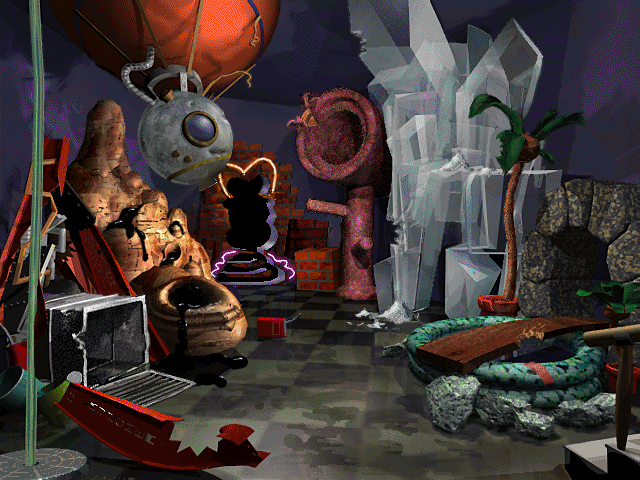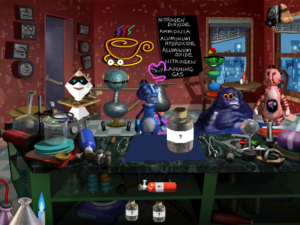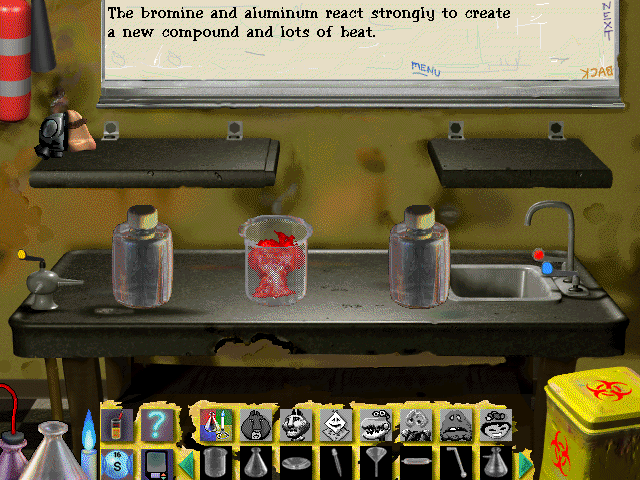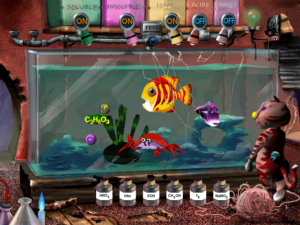Dr. Sulfur’s Night Lab 

Box art for Dr. Sulfur’s Night Lab, courtesy of Stuart Feldhamer via MobyGames.
Science is a tough subject for an educational game. Looking at a sample of edutainment games from the 80s and 90s, I’m willing to say that a large portion of them are about math, maybe because math is easier to randomly generate. The math action-adventure game Troggle Trouble Math, for example, can automatically spin up an endless number of story problems by plugging numbers into a handful of templates. Language arts are a good fit for a computer game too, because it’s another reproducible subject that mostly happens on paper.
Compare that with science, a subject that benefits so much from hands-on experimentation that a computer game can’t necessarily supply. The best science lessons are the ones where students get to mix liquids together or play with magnets or set things on fire. In fourth grade, my science teacher did an experiment where we had to identify sugar, salt, and flour by taste alone, and as hokey as that was, it’s stuck with me for two decades, so he must have been onto something. It’s more challenging for an educational game to reproduce the value of an exercise like that.
Last year, I talked about MECC’s Science Inquiry Collection, which taught scientific subjects — like water quality or dental health — through an investigative process. This is, I think, the right way to do it. But compared to math games that can infinitely generate math problems, there’s only so many types of unique investigations or experiments that developers can reasonably fit into one science game.
By that measure, Dr. Sulfur’s Night Lab might be the most ambitious science edutainment game I’ve ever encountered. Released by textbook publisher McGraw-Hill’s short-lived computer game division in 1996, Dr. Sulfur is a game about chemistry. And to achieve that, the designers tried to recreate the joy of playing around in science class.
In this game, you’ve been drafted to help the mysterious Dr. Sulfur, whose extravagantly designed science lab (resembling what an elementary school kid imagines a cool science lab looks like) has been attacked by a horde of genetically engineered mutants (sure!). Your task is to repair Dr. Sulfur’s lab by solving chemistry problems that conveniently tie into the game’s learning objectives. Dr. Sulfur has team of freaky assistants who each specialize in a different type of matter, like acids, bases, and metals, and they have activities to complete that require your knowledge about chemicals and their physical properties, how they interact with other compounds, and how they’re used in everyday life.

This is what a laboratory looks like… right?
The box for Dr. Sulfur’s Night Lab gives a recommended age range of 9 and up, but I’d imagine the target audience is closer to late middle school. This is not simple or accessible content. The game’s exercises vary in complexity — some of them are matching games, others are more elaborate chemical puzzles — but they never talk down to the player. They deal with head-on with unintuitive concepts like molecular bonds, and they assume a baseline knowledge about chemistry that could be tricky for kids to pick up mid-game. They feels like they were designed as a supplement to chemistry lessons, not as a way to learn about it on their own. Yet despite the heavier subject matter and the vivid, creepy realization of Dr. Sulfur’s crazy laboratory, it’s all the more unusual that Dr. Sulfur plays like any run-of-the-mill kids’ game from this period, featuring wacky characters with wackier voices and arbitrary learning activities, shoehorning in unrelated subjects like music in an attempt to appeal to a wider audience.

Meet Dr. Sulfur’s assistants. They each specialize in a different type of matter and they all talk a little too much
The real game-changer, though, is the game’s chemistry lab. While Dr. Sulfur’s Night Lab doesn’t draw too much attention to this, one of the rooms in Dr. Sulfur’s headquarters is a chemistry lab for conducting experiments, and it contains a fully featured chemistry simulation. The developers at McGraw-Hill managed to program how every single chemical in the game interacts with every other chemical, to such an extent that you can use it to replicate real-life science experiments. It’s such a big undertaking that I didn’t believe it at first.
The lab comes decked out with beakers, pipes, burners, scales, fans, eyedroppers, and whatever other equipment you need to play with the 117 chemicals in the game’s inventory. Dr. Sulfur provides a list of sample experiments to conduct, ranging from innocuous science fair staples like making a vinegar-and-baking-soda volcano, all the way to the incredibly dangerous exercise of making TNT (!!!), something that would never ever ever be allowed in schools. (The game reminds you not to try these experiments at home, and not to try the most dangerous ones anywhere. “You have to wait until you’re a grown-up to destroy things!” Dr. Sulfur’s assistant explains.) You’re not limited to the built-in experiments either; if you want to mix methane and sulfur over an open flame to make a poisonous gas from the safety of your home, you could do that, if you really wanted to.
Could they really have accounted for every property of every chemical? To test how far the simulation goes, I tried to recreate a dangerous experiment that you might see in science class: making nitrogen triiodide, a highly volatile contact explosive. (Thanks to my brother for showing me videos of nitrogen triiodide blowing up when I was in high school, which is the only reason I remembered this.) I found a guide for science teachers about how to create nitrogen triiodide and followed it to the letter in-game, setting up a ring stand with filtered paper and using the exact mixture of chemicals described in the instructions. Sure enough, it worked! It left behind a dark, volatile powder that detonated on the slightest touch. I was shocked that the game bothered to include such an obscure reaction that’s not part of the built-in exercises.

Don’t worry, Dr. Sulfur’s lab has an “invisible shield” to keep you safe from the virtual flames
This is unbelievable! From the cover art, Dr. Sulfur looks like it’s going to be like a mad scientist toy playset, oozing over with colorful fluids without actually teaching you much. But this is the real deal. I mentioned earlier that science education games are limited by how many different investigations or experiments they can fit in. Dr. Sulfur is the rare game that breaks this rule. Nothing can fully replace an in-person experience, but Dr. Sulfur‘s simulation of chemistry is so thorough that it could be an acceptable substitute for doing simple experiments in science class. That is an huge achievement. I can’t think of any other educational game from the CD-ROM era that even comes close to this in scope.

Sourpuss needs to balance the chemical levels in her aquarium, one of the many activities to pull you away from the chemistry lab
So why does the game treat it like a side attraction? Players are required to do a handful of sample experiments in the chemistry lab in order to beat Dr. Sulfur’s Night Lab, but the game quickly leaves it behind to spend more time with Dr. Sulfur’s wacky assistants, with their long-winded stories and awkward chemistry-inspired activities. If the lab serves any functional purpose for the rest of the game, it’s only to serve as a reference catalog about chemical compounds for players to use in other activities. This lab portion of the game seems to be intentionally open-ended for kids and teachers to make their own experiments, and while that’s appreciated, it also means that the full extent of the lab can be easily ignored in a game built around activities and objectives.
(As a caveat, I did not have access to a physical copy of this game. The game’s manual might emphasize the lab more, but either way, it’s not something that comes across in-game.)
(UPDATE 2/23/22: @ArcOnInternet on Twitter says the game’s manual does not include any additional experiments! Unless there was a detailed teacher’s guide, it really does seem like the game barely acknowledges the full breadth of the lab.)
It’s baffling to me that Dr. Sulfur’s Night Lab doesn’t recognize its own strengths. There’s an entire chemistry lab simulation on this CD-ROM! Whole other titles from his period have tried to be interactive science labs, like Maxis’s Widget Workshop or the Discovery Channel’s Invention Studio, and they still didn’t accomplish what Dr. Sulfur gets away with in, effectively, a side room. Why is this not the focus of the entire game? The credits for Dr. Sulfur list separate but overlapping teams for “Activity Content” and “Chemistry Content,” suggesting this game might have been built by committee, like there was a mandate to include a certain number of distinctive exercises and learning goals, like it was one of the textbooks McGraw-Hill was accustomed to publishing.
What a remarkable near-triumph. Dr. Sulfur’s Night Lab contains one of the most accomplished science education tools from the CD-ROM era, and it’s hidden inside an educational game that, on the surface, looks like it could just be any other piece of software that had trouble turning science class into a computer game.

This was awesome to read and to learn about, and food for thought! (Came here through Twitter)
Your blog is amazing. Great read and so many gems to be discovered.
The only way this could get better is if you would make standalone runnable versions of the old games like the also awesome Collection Chamber blog does: https://collectionchamber.blogspot.com/
Love your blog. This game’s real-deal chemistry simulation sounds like it does what Simon & Schuster’s Apple II title Chem Lab didn’t manage to do. As a middle-schooler I bought that game expecting that you could perform any experiment you wanted, but it turned out to be a very limited, scripted experience in which every scenario only supported 2-3 reactions.
Ivo: I’ve heard folks express that those standalone repackages are helpful (any copyright issues aside), but on this blog, I’ve wanted to focus on showing people how to run emulators so they can play these games and others on their own! Check out the Resources tab, where I’ve tried to collect some guides on running emulators and finding old games.
John G: Exactly! I had always assumed any attempts to create a virtual lab would be practically constrained by the number of different reactions and experiments you could program in, so it was shocking to see this game actually go all the way with it. Now I really want to talk with the people on the Chemistry Content team to hear what designing something so broad was like.
I don’t know if it’s one of the listed in-game listed experiments (note to readers: changing the difficulty level results in different tasks for all activities including the lab), but I can confirm that you can dissolve gold in aqua regia, and that the two individual acids that comprise it will not dissolve gold on their own.
Aaaand it turns out that’s one of the experiments listed in-game. Looks like I’m going to need to start digging. https://www.thoughtco.com/chemistry-projects-4133589
I had this game as a kid. I completely forgot the name, but some of the silly minigames I still think of from time to time when certain chemistry concepts come up. I remember spending hours on the in-game lab just testing different reactions out. Thanks for the sweet hit of nostalgia.
This game was the foundation for my love of chemistry in school. The lab was my absolute favourite part, but the other activities were fun and really helped with understanding, too. I’ve been trying for a few years now to find a copy that I can run in dosbox but haven’t had any success yet 🙁 . Really want to have this game for my kids to explore. Great post!
This was one of my all time favorite games! Came across this post looking it up to see any viable way to play it again .
Hey, I enjoyed reading your review. I was the Exec Director for the project, a major contributor to the science content and designer of some of the game spaces. I would be delighted to talk with you about why we ended up where we did but I can assure you the teams weren’t siloed. Truth is we had less than eight months to design and build this thing. There wasn’t much time for contemplative thinking. If we had had this review during our build process we would probably have reacted to it. We modeled 2500 reactions over 500 deg C both stoichematrically and visually. One developer did most of the work. It is the best work I have done over my entire career. I saw great application in taking the lab module into a whole host of products not in the edutainment realm (sans flying nose, perhaps) but was not able to sell that idea to the MH brass. Anyway thanks for noticing and a fine review. (But I hope you liked the pipe organ — it was a work of genius and you could actually build such a musical instrument with reasonably accessible gases accurate to 4 Hz across a whole octave). Incredibly obscure but so satisfying 🙂
Whoa, hey there! I’m glad you enjoyed the article, and yes I’d love to hear more about your experiences working on the game and how the science lab ended up happening like this. I’ll reach out by email.